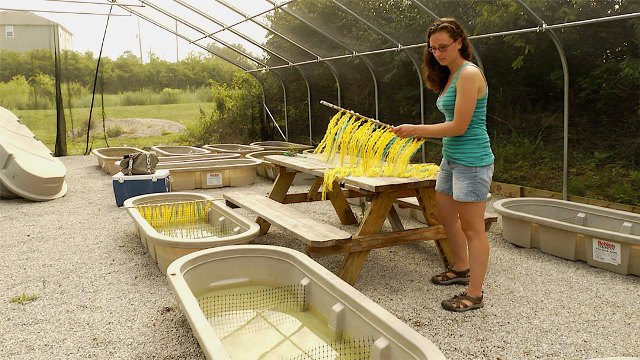By Sarah Geegan
Ten students from colleges across the country came to UK this summer for a competitive research opportunity, unique in multiple senses.
Through a National Science Foundation (NSF) program called Research Experiences for Undergraduates (REU), the students, the first cohort among a total of three over the span of three summers, spent 10 weeks studying suburban ecology and invasive species at or nearby UK's Ecological Research Facility (ERF). The facility, adjacent to The UK/Lexmark Center for Innovation in Math and Science Education (formerly Lexington's Northside Library), offers a unique setting for the study of invasive species; ERF consists of 54 acres nestled in the middle of a suburban neighborhood.
Biology Professor David Westneat led the program, which also provided the unique opportunity for students to research with other students from across the country; the 10 participants are from 10 different institutions.
As many of the students' home institutions lack access to advanced graduate level research programs, the REU exposed students to both a dedicated research facility and faculty mentors.
"The primary goal is to introduce undergraduates to cutting-edge research," Westneat said. "And in our particular REU, we’re focusing on studies of the ecology of invasive species and disturbed habitats, mostly disturbed by humans. The students are really embedded into our research programs and spend the requisite 60 hours a week doing research or research related activities."
 Research projects focused on a range of invasive, or nonnative, species including both plants and wildlife. Many invasive species, such as honeysuckle, are prevalent in the surrounding suburban area.
Research projects focused on a range of invasive, or nonnative, species including both plants and wildlife. Many invasive species, such as honeysuckle, are prevalent in the surrounding suburban area.
"Honeysuckle is a good example," Westneat said. "It’s invading the U.S., fairly strongly and pretty much dominates the landscapes around here. It has a big effect on all sorts of other organisms, both beneficial but also harmful, and of course it’s present in many people’s backyards. There's an interaction between what people are doing in their backyard and what’s happening in natural areas or areas that we would like to call natural that are nearby."
Stephanie Cervino, a rising junior at the College of New Jersey, examined the foraging behaviors of house sparrows, a nonnative "invader" species in North America.
"I'm looking at house sparrows, the parents, and I’m looking at how far they go to get their food and what they bring back, and this is depending on how old their nestlings are too," Cervino said. "I’ll take data at two days of age and at eight days old to see if there’s a difference in the parent's behavior."
By putting metal bands on the birds, Cervino and Westneat were able to identify and track the sparrows. They were also able to monitor their nesting habits, as the birds made homes in birdhouses on the sides of barns.
Dawn DeColibus, a rising senior at Ohio Northern University studied tall fescue, a cool-season perennial grass. Working both at ERF and at Shaker Village, she examined how well the plant persists in a native warm season restoration.
Ben Leffew, a UK student pursuing a Master's in Plant and Soil Sciences, assists in the lab that mentored DeColibus.
"That's the focus of my research," Leffew said. "Trying to link the underground processes, the herbicide, the fire, everything that goes along with a restoration as to how well that tall fescue comes back and are there any spatial relationships that either help it or hurt it along the way."
One of Leffew's and DeColibus' research questions involves the relationship between the grass and endophyte, a fungus: whether the endophyte gives tall fescue an advantage in drought or heat stress related conditions.
"So in testing for the fungus, we’ll go out and we’ll clip tall fescue close to the ground and then we’ll bring it back into the lab," Leffew said.
With both field work and lab work, the program aims to expose students to a full array of research, something Westneat said is rare for most undergraduates. He added that exposing the students to research is beneficial in several ways, even if they don’t decide to go into research themselves.
"These students may become teachers at any level and by having this experience they understand where the knowledge that they’re teaching has come from and all of the challenges that are required to overcome to actually learn something new," Westneat said. "I think that’s a really important value of engaging in research."
Westneat credits the REU in which he participated as an undergrad for influencing his decision to pursue science. He said he hopes this experience will prove equally beneficial for the 10 students.
"Part of it is fairly simple—of just figuring out whether the intensity of doing this on long days is what somebody likes," Westneat said. "Do they enjoy it so much that they don’t care about heat or insects or poison ivy and continue to be enthused by finding out something new about the world around them? So it’s that curiosity I think that we’re looking for in students and that we want to foster and give it a chance to blossom in this setting."
The students will present their research and experiences at 8:30 a.m., on Friday, August 3 in room 109 of the Thomas Hunt Morgan Biological Sciences Building.
